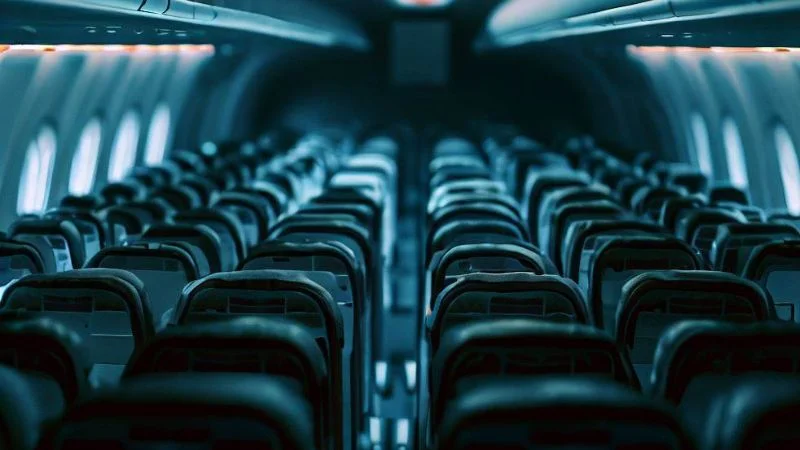How Many People Can Fit on a Plane? Different Plane Sizes Explained

As participants in Amazon Associates and other programs, we earn from qualifying purchases. This comes at no additional cost to you. For more details, see our Affiliate Disclosure.
Air travel has revolutionized how we explore the world, connecting people and places like never before. Flying has become an essential part of our lives, with hundreds of airlines operating thousands of flights daily. However, as anyone who has flown before knows, planes come in many different shapes and sizes, which leads to the question: how many people can fit on a plane?
The answer is not as straightforward as you might think. The number of passengers that can be accommodated on a plane depends on various factors, including the plane’s size, its seating configuration, and the airline’s priorities. In this article, we’ll look at different plane sizes and explore how airlines determine how many passengers can be onboard.
Introduction to Plane Sizes and Seating Configurations
Air travel has revolutionized the way we explore the world, allowing us to reach destinations that were once unreachable. Today, airlines operate thousands of flights daily, connecting people and places like never before. However, as anyone who has flown before knows, planes come in many different shapes and sizes, each with its unique passenger capacity. Understanding how many people can fit on a plane is essential for airlines to maximize their revenue and for passengers to choose the most comfortable option for their journey.
The passenger capacity of a plane depends on several factors, including the plane’s size, its seating configuration, and the airline’s priorities. Small planes, such as regional jets and turboprops, typically carry fewer than 100 passengers. Medium-sized planes, such as narrow-body jets like the Boeing 737 and Airbus A320, can carry up to 200 passengers. Large planes, like wide-body jets such as the Boeing 747 and Airbus A380, can carry 200 to over 800 passengers.
However, the number of passengers that can be accommodated on a plane is not solely determined by its size. The seating configuration, layout, and spacing of seats can also affect passenger capacity as airlines try to balance passenger comfort with profitability.
Factors Affecting Passenger Capacity
The number of passengers that can be accommodated on a plane is determined by several factors, including the plane’s size, seating configuration, and the airline’s priorities. Let’s look at these factors and how they affect passenger capacity.
- Plane Size: The size of the plane is one of the most important factors in determining how many passengers it can carry. Larger planes typically have a greater passenger capacity than smaller ones. However, this is not always the case, as some smaller planes have been designed specifically for high-density seating configurations.
- Seating Configuration: The layout and spacing of seats on a plane can significantly impact passenger capacity. For example, some airlines have introduced high-density seating configurations on their planes, allowing them to accommodate more passengers in the same space.
- Airline Priorities: Airlines have different priorities when it comes to passenger capacity. Some airlines prioritize passenger comfort and offer more spacious seating arrangements, while others prioritize profitability and maximize capacity by introducing high-density seating configurations.
- Cargo Capacity: The amount of cargo that a plane can carry can also affect passenger capacity. Planes that carry large cargo may have less space available for passengers and may need to reduce passenger capacity accordingly.
By considering these factors, airlines can determine how many passengers they can accommodate on a plane. However, the number of passengers that can fit on a plane is not set in stone and can vary depending on the airline’s priorities and other operational considerations.
Small Planes: How Many People Can Fit?
Small planes, such as regional jets and turboprops, are typically designed for short-haul flights and have a smaller passenger capacity than larger planes. However, they are still essential to the aviation industry, connecting smaller communities and providing feeder services to larger airports.
The number of passengers that can fit on a small plane varies depending on the plane’s size and seating configuration. For example, a Bombardier CRJ200 regional jet can carry up to 50 passengers, while a smaller plane like a Cessna 208 Caravan turboprop typically carries up to 9 passengers. Below is a table that shows the typical passenger capacity for some popular small planes:
| Plane Model | Typical Passenger Capacity |
|---|---|
| Cessna 208 Caravan | 9 |
| Pilatus PC-12 | 9-11 |
| Beechcraft King Air 350 | 9-11 |
| Embraer E145 | 50 |
| Bombardier CRJ200 | 50 |
It’s worth noting that while small planes may have a smaller passenger capacity, they often have more frequent flights to smaller destinations, making them an important part of the aviation ecosystem.
Medium Planes: How Many People Can Fit?
Medium-sized planes, also known as narrow-body jets, are the workhorses of the aviation industry, flying both domestic and international routes. These planes typically have a single aisle and can carry up to 200 passengers.
The number of passengers that can fit on a medium-sized plane depends on the plane’s size and seating configuration. For example, a Boeing 737-800, one of the most common narrow-body jets, can carry up to 189 passengers. Other planes in this category, like the Airbus A320, can carry similar numbers of passengers. However, airlines may configure the seating arrangements differently to prioritize passenger comfort or maximize capacity. Below is a table that shows the typical passenger capacity for some popular medium-sized planes:
| Plane Model | Typical Passenger Capacity |
|---|---|
| Airbus A319 | 124-156 |
| Boeing 737-800 | 162-189 |
| Airbus A320 | 150-186 |
| Boeing 757-200 | 178-234 |
Medium-sized planes are a versatile airline option, allowing them to serve both short and medium-haul routes while balancing passenger comfort and profitability.
Large Planes: How Many People Can Fit?
Large planes, also known as wide-body jets, are designed for long-haul flights and can carry many passengers. These planes typically have two aisles and can carry 200 to over 800 passengers.
The number of passengers that can fit on a large plane depends on the plane’s size, seating configuration, and the airline’s priorities. For example, the Boeing 747-8, one of the largest commercial planes in the world, can carry up to 467 passengers in a typical seating configuration. On the other hand, the Airbus A330-200, a smaller wide-body jet, can carry up to 246 passengers. However, airlines may configure the seating arrangements differently to prioritize passenger comfort or maximize capacity. Below is a table that shows the typical passenger capacity for some popular large planes:
| Plane Model | Typical Passenger Capacity |
|---|---|
| Airbus A330-200 | 246-293 |
| Boeing 777-300ER | 396-550 |
| Airbus A350-1000 | 350-440 |
| Boeing 747-8 | 467-605 |
| Airbus A380 | 500-853 |
Large planes are essential for long-haul flights and can carry many passengers, making them an important part of the aviation industry.
Superjumbos: How Many People Can Fit?
Superjumbos, also known as very large aircraft (VLA), are the largest commercial planes in the world and are designed to carry a massive number of passengers. The most well-known superjumbo is the Airbus A380, introduced in 2007 and can carry up to 853 passengers in a typical seating configuration. The plane’s size allows for various luxurious amenities, including onboard showers, bars, and private suites.
The number of passengers that can fit in a superjumbo depends on the plane’s size and seating configuration. For example, the Boeing 747-8, a large plane not considered a superjumbo, can carry up to 605 passengers. However, the Airbus A380 is currently the largest commercial plane in operation and can carry up to 853 passengers in a typical seating configuration. It’s worth noting that airlines may choose to configure the seating arrangements differently to prioritize passenger comfort or maximize capacity. Below is a table that shows the typical passenger capacity for the Airbus A380:
| Plane Model | Typical Passenger Capacity |
|---|---|
| Airbus A380 | 500-853 |
Despite their large passenger capacity, superjumbos have become less popular in recent years due to the high operating costs and the COVID-19 pandemic’s impact on air travel demand. Airbus recently announced that it would be ending production of the A380, signaling a shift away from superjumbos and towards more efficient, smaller planes.
Passenger Comfort vs. Maximum Capacity
Airlines must balance passenger comfort with maximum capacity when determining how many passengers can fit on a plane. While adding more seats to a plane can increase profitability but also hurt passenger comforts, such as legroom and seat width.
To address this issue, some airlines have introduced premium seating options, such as business or first class, which offer more space and amenities at a higher price point. Other airlines have prioritized passenger comfort in their seating arrangements, offering passengers more legroom or wider seats.
Despite the potential trade-off between passenger comfort and maximum capacity, airlines must ensure that their planes are profitable to stay in business. This has led some airlines to introduce high-density seating configurations, which can significantly increase the number of passengers that can fit on a plane. However, these configurations can also make the flying experience less comfortable for passengers.
Ultimately, prioritizing passenger comfort or maximum capacity is a balancing act for airlines. While some airlines may prioritize one over the other, most strive to balance the two to ensure a positive flying experience for their passengers while remaining profitable.
How Airlines Determine Passenger Capacity
Airlines determine passenger capacity by considering various factors, including the size of the plane, its seating configuration, and the airline’s priorities. Here’s a closer look at how airlines determine passenger capacity:
- Plane Size: The size of the plane is one of the most important factors in determining passenger capacity. Larger planes typically have a greater passenger capacity than smaller ones. However, this is not always the case, as some smaller planes have been designed specifically for high-density seating configurations.
- Seating Configuration: The layout and spacing of seats on a plane can also affect passenger capacity. Some airlines have introduced high-density seating configurations on their planes, allowing them to accommodate more passengers in the same space.
- Airline Priorities: Airlines have different priorities when it comes to passenger capacity. Some airlines prioritize passenger comfort and offer more spacious seating arrangements, while others prioritize profitability and maximize capacity by introducing high-density seating configurations.
- Safety and Regulatory Requirements: Airlines must comply with safety and regulatory requirements when determining passenger capacity. This includes factors such as the number of emergency exits and the amount of space required between seats.
By considering these factors, airlines can determine the maximum number of passengers they can accommodate on a given plane. However, airlines may also reduce passenger capacity to prioritize passenger comfort or comply with safety and regulatory requirements. Ultimately, the decision to determine passenger capacity is complex, requiring consideration of many different factors.






